Active or Passive
|
Silver Member Username: MixneffectOrangevale, Ca. USA Post Number: 561 Registered: Apr-05 | For the sake of the arguement, lets ellaborate further on X-overs. Please give evidence proving why your choice is better in either sound quality, convenience, price, functionability, or whatever... I encourage everyone to pitch in their .02 worth. |
|
Gold Member Username: Mikechec9Http://www.cardomain.c... Post Number: 1631 Registered: May-05 | sweet. we really have to start more of these. There are numerous benefits of going active. but primarily, in an active set-up, each driver is dedicated its own amp. this means each amp is required to produce less power because it's only for a narrow range of frequencies. that is, the amp is running far more efficiently focusing all its power accross the ENTIRE frequency range for only that one pair of drivers-the pass range AND the attenuated range. in addition to maximum damping, an active system affords you the ability to specify an optimal impedance for a driver, particularly in a given install. not to mention the advantage it has over the passive's yielding problems with potential intermodulation distortion. but the loss of dynamics/performance, for which i can personally vouche (having had my 6.3 run both actively and passively), is the most noticeable of the passive xo deficiencies. I have recently been considering going active with a dyn 360 set, myself with 200 watts/ch. but the set xo hz are optimised for kickpanel installs w/the highs down low as per jon. my preference for staging is the high a-pillar, but that's not an option if i go passive. not for the best results anyway. passives are less expensive and cut out the need for the tedious tuning required with actives. but there are few passives that will show up a well tuned active xo. |
|
Silver Member Username: RedskinLondonEngland Post Number: 222 Registered: Dec-03 | Although most sources will advise that active is better, my view is that both can be made to sound good, but it is much easier with active. Passives while cheap and easy, are very much a compromise especially in a car. When XO designers are producing xo's for home hi-fi they know roughly where the speakers will be placed in relation to the listner, assuming we're talking about a resonable quallity system that the manufacturer would expexct the speakers to be placed in front of the listner about 6-10ft apart. This gives them a head start as they can tailor the xo in conjuction with the speakers to give a smooth frequency response at the listening position. In a car though all this changes, car A will not have the same speaker positions as car B. meaning that a xo tailored to car A will quite possibly sound awful in car B. With active xo's it is very easy to adjust the properties of the xo to tailor your speaker to your car. Passives tend to add to group delay problems whereas actives do not to the same extent,and can take them away if they have a time delay function. Less distortion and better seperation with active. Of course the advantages could just be a conspiracy put about by amp manufacturers to boost their profits. I've had active and passive systems and both sounded good and my current system has quallity passives that are really good.When Rockford first came to UK I listened to one of their systems with 4x10", 4x6.5", 4x4" and 4 tweeters all driven passively from 1 amp that sounded very good. Maybe I'm looking back with rose cloured glasses but it still rates as one of the better systems I've heard. Try this link..... http://sound.westhost.com/articles.htm for mor info on why active is better. |
|
Gold Member Username: Mikechec9Http://www.cardomain.c... Post Number: 1632 Registered: May-05 | *edit/correction* "i had recently been considering going 'passive' with a dyn 360 set.." |
|
Silver Member Username: MixneffectOrangevale, Ca. USA Post Number: 573 Registered: Apr-05 | The advantages of fine tuning is great for people that change their mind a lot, or for people that place speakers in odd places and expect an x-over to make electronic corrections to make up for loss of physics. This is what I base my opinion on; I believe that systems should be custom tailored (speaker placement) for each listening area as the first priority. Retrofitting the surroundings is just as important (building custom kick pods for comps, angled enclosures for door installs, removing the trunk lid in a hatchback, or opening the rear deck lid in a sedan, etc...). Once all physical adjustments have been satisfied, the electronic fine tuning may begin. This is when I would design the passive x-over. As far as efficiency is concerned; I would compromise efficiency for quality any day. I am in favor of Class A amplifiers. IMO designating each driver to a different amplifier, or channel so that it will concentrate on a limited frequency range is a compromise of efficiency for quality of sound (phasing). Active/electronic X-overs have cheap components. For instance; The size of an average electronic x-over is about 6"X6"X2". Most quality capacitors, and coils become quite large when it comes to the bigger values, not to mention resistors. Other drawbacks with active/electronic X-overs are gain(boost) and sophistication. I wouldnt expect a X-over to increase volume. The more circuits that are involved also increase distortion and phase delays. |
|
Silver Member Username: RedskinLondonEngland Post Number: 223 Registered: Dec-03 | Cheap electronics have cheap components no matter wether active or passive. No amount of speaker placement makes up for the fact that you will be very close to one set of speakers compared to the set on the passenger side. Active xo's with time delay put you in the virtual centre of your speakers. Are you advocating a totally passive system setup then? |
|
Gold Member Username: Mikechec9Http://www.cardomain.c... Post Number: 1633 Registered: May-05 | "as far as efficiency is concerned; I would compromise efficiency for quality any day. I am in favor of Class A amplifiers. IMO designating each driver to a different amplifier, or channel so that it will concentrate on a limited frequency range is a compromise of efficiency for quality of sound (phasing)." i too am in favor of class A amps when practical (affordable). "efficiency" as in the amp being able to do MORE for the driver's production/performance. to provide more control, as opposed to some of that power being wasted/misdirected. that is what i meant by efficiency. not mearly being able to use less power. rather, all of the power spent is utilized throughout the entire frequency range of the driver (with yet still in reserve for transients). thus making the system perform better, resulting in increased quality. in addition, the placement of drivers IS key. but there is still going to be room for individual t.a. even after taking such measures, a feat not afforded a passive xo. i would, however, be interested in creating a custom passive after the best placement of the drivers like you suggested, but that is probably a bit further down the road for myself (and many others). if you use the components' standard/included xo, you are pretty much stuck. there is no custom tailoring for each listening area. but to be able to build one personally would be a true asset. |
|
Silver Member Username: MixneffectOrangevale, Ca. USA Post Number: 576 Registered: Apr-05 | Yes I am in favor of a totally passive X-over system over an active or electronic x-over or any other hybrid that may exist. lol. As far as seating arangement in a car compared to the assanine stock speaker placement is concerned; I would rather not mess with an electronic x-over. I would rather keep things simple. Electronic time delays, and stuff like that do not make up for loss of physics anyway you slice it. I mix live sound, thus my username. I am not a DJ (lol). I do not spin records at underground rave parties (lol). I mix volumes of microphones and line level sources. One of the biggest factors in mixing is staging. Placement of people, microphones, instruments, and yes of course "SPEAKERS". As you may have already figured it out, there are many bad recordings out there. The biggest factor is staging. You can use cheap mics and cheap monitors, but if you set up right, the recording will be more pleasant, and true. |
|
Gold Member Username: Mikechec9Http://www.cardomain.c... Post Number: 1635 Registered: May-05 | "Electronic time delays, and stuff like that do not make up for loss of physics anyway you slice it." uh hugh!!  no, but actually it's still physics. again, it's best to get the physical driver placement as close to perfect as possible. but that's as much as you can do physically, according to such laws, i agree. then it's necessary to physically delay the time it takes for those waves to reach your ear (unless you drive a mclaren), as well as delay the signal's degree (with respect to the wavelength at the xo hz. i.e., phase). that is, of course, if it's the best staging/imaging that you are after. in such a case, a car is just to darn imperfect to not use them. |
|
Gold Member Username: Mikechec9Http://www.cardomain.c... Post Number: 1637 Registered: May-05 | i also love mixing. but not live, just studio. i couldn't imagine having to change the levels on the fly based on what's happening live. i've seen many a "sound man" get attacked. wyclef was just one such aggressor, lol. he took it pretty serious. i would imagine that's when you really require true skill. kudos |
|
Silver Member Username: MixneffectOrangevale, Ca. USA Post Number: 577 Registered: Apr-05 | Ya, "flying faders" I preffer to have my headphones on one ear and listen with the other. It helps me do mix and record, although I am not a professional or perfect for that matter. But in relation to what we are discussing (time delays), I would rather not deal with that stuff or the feedback reducer. No way, I like it natural. |
|
Silver Member Username: MixneffectOrangevale, Ca. USA Post Number: 579 Registered: Apr-05 | Oh I almost forgot. Another attribute of the passive X-over is the impedence correction. This is something that I have not seen and/or heard of when it comes to active/elctronic X-overs. There are many other X-over tricks that can be performed with passive X-overs that help smooth out the frequency response. I admit. There are many similarities among them, but like I said. "I like it natural." Natural to me means less electronic parts, which means more of the original signal. |
|
Silver Member Username: RedskinLondonEngland Post Number: 227 Registered: Dec-03 | I thought impedence correction was just to get a nice flat load to keep the passive xo working as it should. So no need for that when using active. "I like it natural." I always wonder about this. I know my ears are just not that sensitive. I have no interest in classical music. I doubt if I own any well recorded music. People always say the goal for SQ is "as if it were live", but I've been to loads of concerts(proberbly why my ears aren't that sensitive)and if my system sounded like some of them I'd be horrified. I can go with the less electronics in the signal path is good but that signal has gone through so much of it before it gets anywhere near my system I feel vindicated to use whatever means are available to make it sound good to my ears. The other thing with with quality capacitors coils etc, at least here in UK, is it is difficult and pricey to get the larger values required for the low end and they aren't exactly cheap to start with. |
|
Gold Member Username: Mikechec9Http://www.cardomain.c... Post Number: 1690 Registered: May-05 | "that signal has gone through so much of it before it gets anywhere near my system I feel vindicated to use whatever means are available to make it sound good to my ears."  |
|
Silver Member Username: MixneffectOrangevale, Ca. USA Post Number: 616 Registered: Apr-05 | As far as "as if it were live" is concerned, is reffering to instruments being played live in a studio. It does not reffer to live concerts at the local stadiums. "as if it were live" reffers to making a judgement call between two signals as if you were standing in front of the musician playing it in a studio or at least a decent enclosed area where the sound being recorded has some type of resonant atmosphere. This term is used to describe a judges sources when an audiophile comparison between two speaker or speaker systems are being compared. at least here in UK, is it is difficult and pricey to get the larger values required for the low end That was exactly my point. I thought impedence correction was just to get a nice flat load to keep the passive xo working as it should impedence correction is a cap and a resistor inseries across the poles after the passive crossover and right before the speaker. It is used to reduce the "impedence" at the Fs. Most drivers have a huge impedence at Fs. It goes off the charts. It is that great. Thats why the impedence correction has been created. Active crossovers do not have em. |
|
Anonymous | Why don't yall restart this thread and tell what you mean by ACTIVE and PASSIVE. |
|
Silver Member Username: MixneffectOrangevale, Ca. USA Post Number: 618 Registered: Apr-05 | 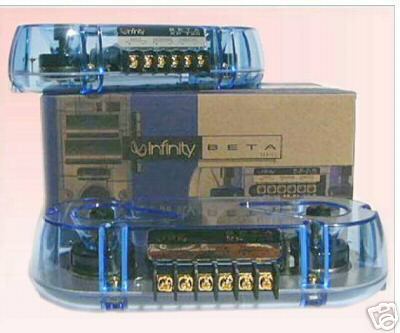 Passive crossover = Does not gain or boost any frequesncies. It is used to just divide the frequency spectrum to suit each driver, for a better result. 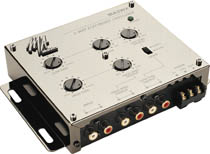 Active crossover = Electronic component that is connected prior to the amp. This component has options to boost or cut frequencies. There are many characteristics that an active crossover has that it shares with an equalizer. It behaves like an EQ as it tries to simulate a passive crossover. There are also drawbacks to such features or the lack there-of. Dont let the sizes fool you. They are actually reversed in real life. The passive is much smaller than an active crossover. lol |
|
Gold Member Username: Mikechec9Http://www.cardomain.c... Post Number: 1695 Registered: May-05 | i.e., i sold these passives (very solid state-of-the-art. all four for one 3way set): 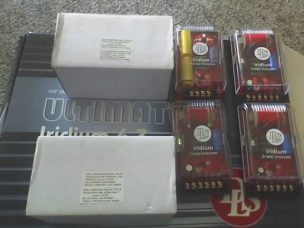 for this far more useful active xo (even w/the eq functions aside). 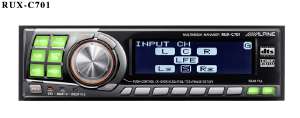 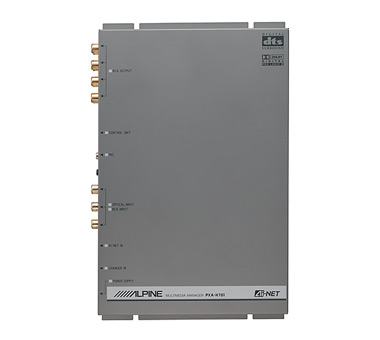 http://www.dealtime.com/xPR-Alpine_PXA_H701_Multi_channel_audio_processor~RD-210755161732 |
|
Gold Member Username: Mikechec9Http://www.cardomain.c... Post Number: 1696 Registered: May-05 | i guess my point is, in order to pass up quality passives like these, there must have been an overwhelming advantage (all the above stated) to going active. 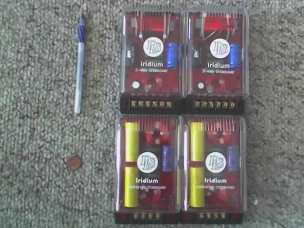 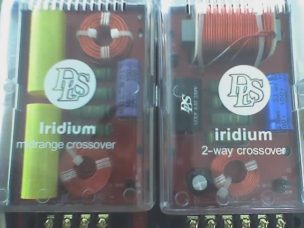 |
|
Silver Member Username: MixneffectOrangevale, Ca. USA Post Number: 622 Registered: Apr-05 | Ya some of those are nice bendor caps and air core coils. Thats something you will not find in the active xover. You might get lucky if you get electrolitic caps. lol |
|
Silver Member Username: RedskinLondonEngland Post Number: 228 Registered: Dec-03 | I thought impedace equalization with and cap anb resistor was sed to flatten the rise in impedance caused by the voice coil inductancce but to damp the the peak at Fs requires a series notch filter? "Is it live/natural?" This then comes down to a percieved quality of a system. In my view once you get to a certain point of spending your ears will not notice any better performance but your brain commands you to accept that your newest addition(or subtraction for those searching for cleanest signal path) really was worth the extra cash. |
|
Silver Member Username: MixneffectOrangevale, Ca. USA Post Number: 623 Registered: Apr-05 | I am a musician, and have a well tuned ear. When you have been a musician for more than two decades, it makes distinguishing between two sounds very easy. If you are questioning my ability to tell the difference between two speakers or two sounds of any sort, well you are very wrong my friend. I have met a lot of people that do not have a musical ear, but they still argue that anyone else couldnt do better. I am sure that if there are any musicians reading this, they would understand. For the rest of the world that does not have a good ear, go ahead and buy your Bose system and believe that you have the best speaker available. Just do us all a favor, dont give advice if you have no credentials. |
|
Silver Member Username: RedskinLondonEngland Post Number: 230 Registered: Dec-03 | Whats any of that got to do with my last post? Was I insulting your ears, I didn't think I was. If your ears are super tuned congratulations. I couldn't claim that mine are. My point is that of diminishing returns. Even as a muscian there must be a price point at which a note played on instrument A sounds no better than that of instrument B or that mixing desk A sounds no better than mixing desk B that costs more. "Just do us all a favor, dont give advice if you have no credentials." I thought I was just puting forward my view. Obviously your going to state your credentials so I know I am getting correct advice in future. "Passive crossover = Does not gain or boost any frequesncies. It is used to just divide the frequency spectrum to suit each driver, for a better result" Passives can be made to boost frequencies at the crossover point depending on Q of the filter. Also used to cut response to match drivers ounequall sesnitivity. "active filters behave as eq's" I'm not sure. A true active should mimic the charateristics of the passive it is replacing. The fact that manufactures of generic actives add 10,000 other options to further tailor sound doesn't make active xo eq,s. Just like passives proper actives should be tailored to the speakers that they will be driving. |
Main Forums
Today's Posts- Home Audio Forum
- Home Video Forum
- Home Theater Forum
- Car Audio Forum
- Accessories Forum
- All Forum Topics